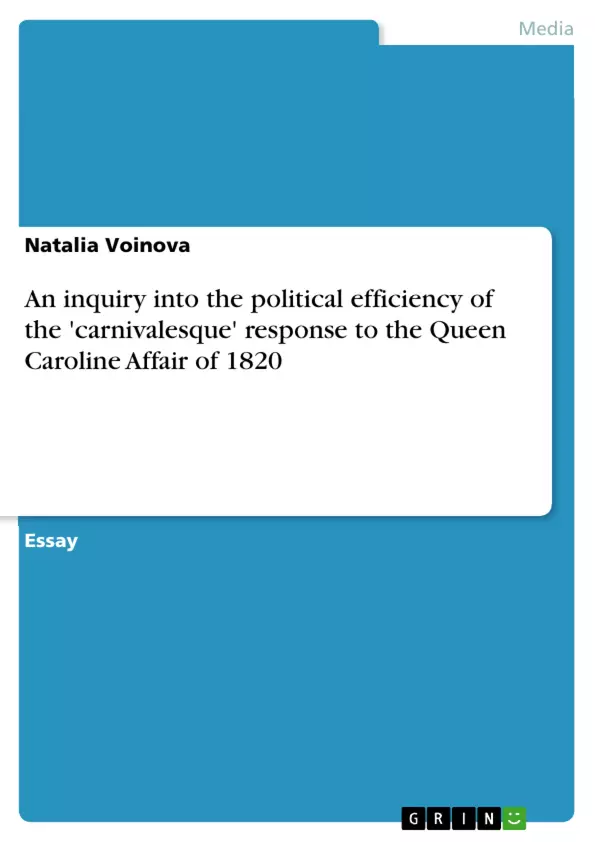Britain was undergoing some important changes. Following the Manchester Peterloo
Massacre of 1819 the government introduced the so-called Six Acts which prohibited
congregation of more than fifty persons on matters regarding the state without
permission, accelerated the speed of prosecution for libel, and put further restriction
newspaper publications.1 By 1824 the act was partially revoked, and 1832 marked the
long-awaited Reform Act, which enfranchised more men and revised representation from
newer boroughs. In this light the Queen Caroline Affair of 1820 provided the occasion
for effective public ridicule of the oppression under the guise of carnivalesque
conviviality and caricature. This movement of the working class from subjects to citizens
through their engagement with fearless carnivalesque subversions of the established
system using the wronged Queen Caroline as the icon of mistreatment by the government
will be the main focus of this essay.
The affair at its core is not more than a domestic quarrel between George IV, and
his unwanted wife, Caroline of Brunswick. In 1795, the king ended his illicit marriage to
Maria Anne Fitzherbert in order to marry a more noble Caroline, the arrangement was
one of convenience for George IV, as the Parliament promised to pay off his substantial
debt if the notorious dandy agreed to live a more subdued life with his new wife. The
marriage was doomed from the beginning when George IV humiliated Caroline before
she even met him when he sent his new mistress Lady Jersey to be her lady-in-waiting.2
Shortly after the wedding, with Caroline pregnant, they separated and Caroline lived
apart from the court. Already by 1807 George IV was attempting to rid himself of his
homely wife by launching a ‘Delicate Investigation’ on the grounds of a rumor that
Caroline’s adopted son was actually her bastard. The investigation concluded that
although some of her behaviour is indiscrete there are no grounds for divorce.3 Despite
her proven innocence, she was ostracized at court, excluded from attending important
state events, and after a series of humiliations and restrictions on seeing her daughter,
Princess Caroline chose to go abroad in 1814.4 After the death of George III, Caroline
elected to return to Britain to claim her rightful place as the Queen beside George IV,
however this proved to be difficult, and this is where the Affair begins.5
Table of Contents
- Introduction
- The Queen Caroline Affair
- A Domestic Quarrel
- The Trial
- Public Reaction
- The Carnivalesque and Public Reaction
- Caricature and the Queen
- The Queen's Return
- The 'People' and Queen Caroline
- The Role of Gender
- Masculinity and Chivalry
- Feminine Virtue and Fidelity
- Conclusion
Objectives and Key Themes
This essay explores the political and social significance of the Queen Caroline Affair of 1820, focusing on how the carnivalesque elements of public reaction, particularly through caricature, served as a means of expressing dissent against the government and the established order. Key themes of the essay include:- The role of the carnivalesque in political discourse
- The use of caricature as a tool for social commentary
- The representation of gender roles and power dynamics
- The complexities of class and social hierarchy
- The relationship between public opinion and political reform
Chapter Summaries
The introduction sets the historical context for the Queen Caroline Affair, highlighting the social and political changes taking place in early 19th century Britain. The affair itself is then outlined, focusing on the contentious marriage of George IV and Caroline of Brunswick, the subsequent trial, and the public's reactions. The essay then delves into the use of the carnivalesque by the public, examining the role of caricature in shaping public discourse and critiquing the ruling class. Specific examples of caricatures, like "Grand Entrance to Bamboozl’em" and "Boadicea, Queen of Britain," are analyzed to showcase the ways in which they subverted royal tradition and reflected the aspirations of the working class. Finally, the essay examines the gender dynamics at play, exploring how the Queen's perceived role as a symbol of feminine virtue and fidelity sparked a debate about masculinity, chivalry, and women's involvement in the political sphere.
Keywords
The Queen Caroline Affair, carnivalesque, caricature, political satire, public opinion, social commentary, gender roles, class, political reform, George IV, Caroline of Brunswick, popular culture, British history.- Quote paper
- Natalia Voinova (Author), 2011, An inquiry into the political efficiency of the 'carnivalesque' response to the Queen Caroline Affair of 1820, Munich, GRIN Verlag, https://www.grin.com/document/192549



